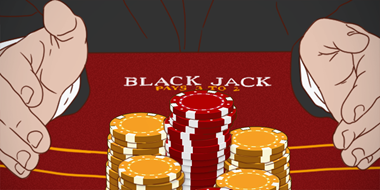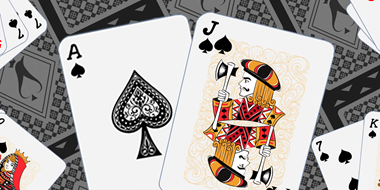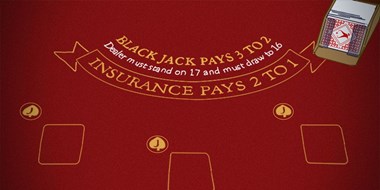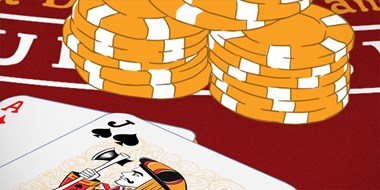For hundreds of years, blackjack has entertained gamblers from novices to experts alike, and today it remains as popular as ever. Whether it is played online or ‘at the felt’, the challenge of beating the dealer in hands that must not exceed a value of 21 is taken on by millions daily who are fascinated by a game that is easy to understand but hard to master.
In this article, we're going to discuss:
- The Beatable Game
- Magic Number 21
- The Rules
- The Advantage of Basic Strategy
- Why Is Blackjack So Popular?
- The Storied History Of Blackjack
- Blackjack Basics
In this comprehensive guide, we will set out to explain the basics before delving a little deeper into strategies that will greatly increase your chances of leaving the table a winner.
At its heart, blackjack, sometimes referred to as a pontoon card game, is a game of skill, strategy, and nerve and therein lies so much of the game’s appeal. Add in too that it has a low house edge and is accessible to all, is it any wonder so many people around the world enjoy its charms?
Intrigued? Want to discover more and learn how to play blackjack? Then read on as this guide details:
An Understanding Of The Crucial Blackjack Rules For UK, US, And International Play
-4cBXc3f7Px.jpg) | This key section lays out the correct manner in which the game is played, from initially taking a seat, to covering ‘hitting’ and ‘standing’, right through to explaining how a player can surrender their hand or request insurance. |
Getting To Grips With Basic Strategy
-ll4UvY4yHj.png) | Pioneered in the 1950s this is a mathematically infallible way to play each hand that will optimize your gains and minimize your losses over the long-term. Armed with this data a player can cut a casino’s advantage down to 0.5%. |
Hand Strength
-le1u6JGqMC.jpg) | While being dealt a natural blackjack hand of an ace and any card valuing 10 is always a thrill there are many other hands that will worry a dealer. Conversely, there are several that will have a player cursing their ill-fortune. To appreciate why a hard 11 is infinitely more preferable to a 16 is the start of an absorbing and rewarding journey. |
Recognizing Blackjack’s Rich And Storied History
-t0EG575Mgd.jpg) | Because as the saying goes: “You have to know the past to understand the present.” |
The Game’s Appeal
-mBbIJNkaWI.jpg) | Requiring skill and judgement within a rigid framework, it is a pursuit that rewards your knowledgeable players. For this reason it is considered the most ‘beatable’ game of its kind. |
Above all else though, the game is fun. Lots of fun. Read on to learn how to play blackjack.
THE BEATABLE GAME
A large part of blackjack’s allure is that it has long been perceived to be ‘beatable’ and this perception continues to this day.
Unquestionably, it is a game that in comparison to its casino cousins, such as craps or roulette, lends itself more to strategy, judgement, and skill. When such good habits become intuitive, a player takes to the felt believing it to be a level playing field.
To what extent it is indeed a game of skill is open to conjecture and there have certainly been a good many gamblers that have walked away from a blackjack table bemoaning their ill-fortune over the years. Yet, when discipline is employed and the count is favorable - meaning the deck is laden with 10s and face cards – and who knows, maybe the dealer is a novice who has not yet 100% nailed down how to deal blackjack, then it can be said that an advantage shifts to the player.
Moreover, blackjack is fundamentally a game of probability, and each dealt card reveals valuable information about the remaining cards. Therefore, when logic is applied, this offers a player a real chance at beating the house.
This thinking first began in the 1960s, when two key published works demonstrated that, by applying basic strategy, it is possible to cut the house edge down to almost zero and even gain the upper hand. Still, this in itself does suggest that blackjack is beatable and that it is fair. For the rest of us, that is enough to reassure us and entice us to the tables.
MAGIC NUMBER 21
Contrary to popular opinion, the ultimate objective in blackjack is not to be dealt a ‘Traditional 21’ as your starting hand. It is not even to get as close as possible to 21. Fixate on the latter and you will bust more times than not.
The ultimate objective is to beat the dealer, and if it is a hard 16 that wins the day, then all well and good. You will have doubled your original stake. You are a winner.
Even so, there is no feeling quite like it when you see any ace and a card amounting to 10 being slid across to you. So long as the dealer does not also hit blackjack you are temporarily invincible having been dealt a combination that aptly occurs on average once every 21 hands.
Yet, the magic number is not the only hand to aspire to. Other strong hands include:
A Hard 20 Should this be made up of two 10s, please don’t split. This is a rookie error because you already have a very strong offering. |
A Soft 18 An ace and a 7 afford the player several options. Most players would ‘stand’ but if it is a multi-deck game where the rules specify the dealer must stand on soft 17 it is often better to double down or hit depending on what the dealer’s upcard is. (This is explained further in the strategy section) |
A Hard 11 Basic strategy suggests that a hard 11 is an extremely powerful hand for a player as there are more tens in play than any other value. |
Individually, the cards too have varying strengths. Aces of course are always desired while 10-value hands (10s, jacks, queens, and kings) are almost always welcomed. Collectively they make up 31% of a single deck. Fours, fives and sixes meanwhile are typically regarded as the weakest of card values, at least when dealt as part of the opening hand. As drawing cards their usefulness can soar if hitting on a soft hand in the 13-16 region.
It should be noted that hand strengths and strategies vary according to deck variation. It is possible to play classic blackjack with up to 8 decks or a single-deck. The scarcity of 10s and face cards in the latter compared to the former skews the strengths and weaknesses of all the other cards available. Again, this is covered in more depth in the strategy section.
THE RULES
Blackjack card game rules are relatively easy to grasp and this makes it the perfect pursuit for beginners and experts alike. So, how do you play blackjack?
-VEcXeyYM0C.jpg) | If you want to play purely for fun then its basic tenets can be understood within minutes. However, if you prefer to play consistently well and greatly increase your chances of winning, then obviously a more comprehensive understanding is recommended. |
Each approach to the blackjack rules is outlined below.
Let us begin with the basics - enough to enjoy an engrossing card game that is second only to poker in its popularity worldwide.
1. Players take a seat, ideally after understanding what the maximum and minimum stakes are for that particular table as this can vary. They are then obliged to place a bet in the markings ahead of them that are sometimes called ‘boxes’, elsewhere ‘spots’.
2. After all the wagers on the table are made, two cards are dealt face-up to each player while the dealer receives either one (if it’s the European variant of the game) or two but with one face-down if it is the more commonly played American blackjack format. The concealed card is called a ‘hole card’.
3. The game is now underway and the ultimate aim is to beat the dealer. This is achieved by compiling a hand that is valued higher than the dealer’s hand but which does not exceed 21. It is also possible to win by having a hand under 22 should the dealer go ‘bust’, a term used for when 21 is surpassed.
4. When dealt the two cards, the player’s options are to either stand or hit, and further cards can then be drawn until the player is either satisfied with their tally or unintentionally goes bust. Once the player’s hand is completed the dealer then takes their turn. They must hit up to the value of 16 and stand when their hand amounts to 17 or over.
5. Should spaces be available on the table, it is permissible for a player to play more than one hand per round. However, most casinos insist the table minimum is doubled on each hand when multi-playing.
6. Blackjack’s unbeatable hand is the one the game is named after and this consists of any ace – that always has the value of either 1 or 11 – and a card valued at 10. Card strengths are detailed below. Only the opening two cards can be counted as a blackjack hand and though it cannot be beaten, should the dealer also enjoy the same good fortune, the hand is tied.
7. If a player is dealt blackjack, they are typically paid 3:2. Otherwise, winning a hand will accrue them the same amount they originally wagered (1:1). In betting terminology this is known as ‘evens’.
8. As mentioned above, an ace can be worth either 1 or 11. It typically begins with an 11 value until a hand exceeds 21 and then it can revert to its lower worth. Face cards meanwhile count as 10 so a hand made up of a king and a 5 is worth 15; a jack and a 4 worth 14. Elsewhere all other cards are their face value (a 4 is worth 4 and so on).
9. Until the middle of the last century, it was common for these cards to be dealt from a single shoe. That occurred until the trait of counting cards increased in volume and casinos responded by upping the number of decks used. It is now the norm for 4, 6 or 8 decks of cards to be employed with the aim of making it harder for players to keep track.
10. The final consideration for understanding how to play blackjack cards, before we break down the various dynamics of blackjack, is that when a player’s cards are dealt they should not be handled by the player. Only the color-coded chips should be touched, sometimes known as ‘checks’ and these can be purchased from the dealer by placing money on the table when a hand is not active.
Hitting
This is a request for another card to be dealt to you by the dealer. To do this it is typical to tap the felt behind your cards with a finger or hand.
The request is made with the aim of improving your hand(s). An additional card or cards will then be drawn one at a time until you ‘stand’ or exceed the value of 21 and ‘bust’.
Standing
When you are satisfied with the total value of your hand, it is necessary to inform the dealer that you do not desire any further cards; that you wish to ‘stand’. This can be done in a number of simple ways.
Simply say ‘stand’ or ‘No more’ if at a casino table and clearly signal by moving your hand sideways, palm down, over your cards. In certain games it is common to place your cards under the chips located in the betting box.
Busting
This is a lost hand due to the player exceeding the value of 21. If the player and dealer both bust the hand is lost regardless. When you bust, you lose.
An example: A player is dealt a 9 and a 4. Their drawn card is another 9. Their hand now totals 22.
Splitting
If a player’s dealt cards are the same denomination, such as two fives or two queens, it is possible to ‘split’ them, thus making two separate hands when it is the player’s turn to act. The original bet must be matched and the hands are then played out one at a time to a conclusion with the dealer settling with each on their own merits.
It is typical to first play the card on the player’s right before moving to the other and for each hand you may draw as many cards as you wish. The only exception to this is with split aces where only a single card apiece is permitted to be drawn. Should the amount of 21 blackjack be reached with either of the split aces the pay-out is equal to the bet, as opposed to the usual one and a half to one pay-out.
To notify the dealer that you want to split, simply place another chip next to the original chip.
Doubling Down
Should your original two cards total 9, 10, or 11 you have the option of doubling your initial bet. This can only be done when two cards have been dealt and not on any subsequent rounds.
To indicate to the dealer that you wish to double down, place an additional chip next to your original chip on the hand. It should be noted that a dealer cannot split or double down.
Once you have committed to this strategy only one further card will be dealt to you and then it is compulsory to ‘stand’.
Some casinos will permit a player to double down for less than the original wager.
Surrender
Depending on the casino blackjack rules, surrender is often, but not always permitted. This strategy affords the player an opportunity to forfeit half of their bet to end the hand immediately.
A player is free to surrender their hand – thereby losing half of their original bet – on viewing their initial two-card hand but cannot do so once a card is drawn or if the dealer has a blackjack card hand.
The intention to surrender is typically indicated by moving a finger from left to right across the felt.
The strategy can either be deployed once the dealer has checked their cards (late surrender) or prior to them checking their hole card for a blackjack (early surrender).
Hard/Soft
A key factor when determining what the difference is between a soft and hard hand lies in recognizing that you cannot go bust when drawing to the former. Some examples illustrate this best:
- A 10-6 hand is a hard 16 and should a third card be drawn it is entirely possible that you exceed 21 and go bust. Indeed, any hand that does not include an ace is regarded as a ‘hard hand’ unless that ace can be counted as a one in which case it becomes a ‘soft’ hand.
- Let’s say you are dealt A-5. That is a ‘soft’ 16. Should you however draw and be given a 6 then the ace reverts to its lowest denominator and you now have a hard 12.
- This is an important consideration not only for your own gaming habits but because casinos vary as to whether it is policy for their dealers to stand on a ‘soft 17’ or to hit. In all blackjack games, the dealer will hit on any hard or soft total of 16 or under.
Insurance
When the dealer’s exposed card is an ace, any player at the table involved in the hand has the option of taking insurance, a side bet in the form of each player betting that the hidden ‘hole card’ is of the value of ten. In value, this wager can only be less than or equal to one half of the initial bet.
If it is revealed that the dealer’s hole card is indeed a 10 or face card the insurance bet pays off at 2-to-1 odds.
With the dealer having made a blackjack hand, they win the main body of the bet (unless of course the player also has a hand of the same value). The player wins the side bet.
To signify that an insurance bet would like to be made, chips are placed at the earliest opportunity on the insurance line, found above the player’s betting box.
Even Money
In the uncommon instance that a player has a blackjack hand and the dealer has an ace showing, the player will be given the option of taking ‘even money’. This automatically affords the player a pay-out of 1 to 1 on their bet before the dealer’s second card is revealed.
The pay-out is honored regardless of whether the dealer has blackjack or not. If the offer of taking even money is refused, the hand plays out as normal.
Push
A push is blackjack’s preferred term for a draw or a stalemate: when you and the dealer have the same hand value. When this occurs, your bet – including your initial wager - will be returned. You do not win anything and you do not lose anything.
Understanding and adhering to these rules will ensure that you realize the optimum enjoyment of playing blackjack, a deceptively simple game designed to build up drama and provide plenty of thrills. Yet, why stop at merely enjoying the game when learning about strategy will enhance your chances at winning?
THE ADVANTAGE OF BASIC STRATEGY
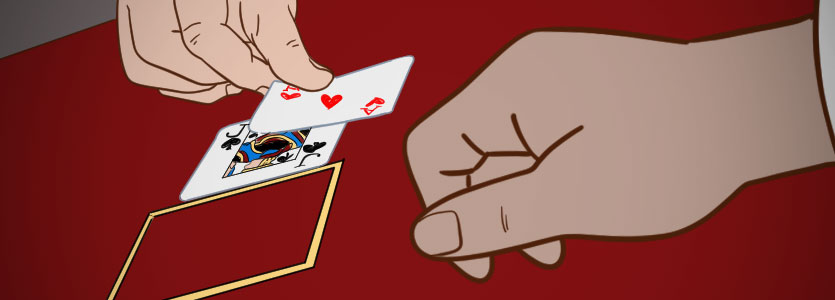
Understanding basic strategy in blackjack grants any player the proverbial keys to the kingdom because it informs them of the mathematically correct way to play a hand. With the game having a rigid structure – as opposed to, say poker where you can never really account for an opponent’s decision-making – it means that armed with such knowledge a player can reduce a casino’s edge to a minimum. For short-term gains, being intuitively aware of strategy is invaluable.
To better comprehend what is essentially a blackjack roadmap, compiled over a great many years by people who knew more about the game than we ever will, let us first begin with a hand example that reveals basic strategy’s worth. We will then see how it guides us through the game’s various facets including:
|
|
|
A widely accepted truism in blackjack states that a player should never risk going bust when the dealer’s upcard is weak. This makes sense, generally speaking.
Basic strategy, however, doesn’t deal in abstract principles but rather hard data. So in this hand example the player is holding a queen and a two and the dealer has a three showing. Basic strategy informs us that there are only four cards that would take the player’s hand beyond the 21 threshold: a ten, jack, queen or king. Conversely there are five cards that would increase the hand’s value into the 17-21 zone. The dealer’s three meanwhile is also relevant as basic strategy tells us it is not as weak as it first appears.
Calculations instruct that it is better to hit in this scenario rather than stand, as perceived logic might suggest. By doing this, the player will win slightly more often.
Surrendering
Now let us move on to some key aspects of blackjack starting with the option that is arguably most misunderstood: surrendering.
If a player believes their hand is very weak against the dealer’s visible upcard, they are permitted to forfeit the hand. In doing so, they lose half of their bet (but crucially retain their other half).
A player can ‘late surrender’ by waiting for the dealer to view their hole-card or ‘early surrender’ which is the more beneficial of the two choices. Unfortunately, both options are too often overlooked by players who regard surrender as weakness.
Yet, basic strategy tells us that when used correctly, a late surrender cuts the house edge by around 0.07% in multi-deck games. It also tells us that when a hand has less than 50% chance of winning, it pays off to surrender over the long-term.
Splitting
As for splitting pairs, again this is an area that can divide opinion while basic strategy steps in and settles the matter with incontestable data.
Splitting a dealt pair affords a player the ability to effectively make two separate hands out of one and this is a rule a novice player tends to take advantage of too loosely. Others meanwhile refrain when it is actually in their best interests to split.
Basic strategy makes things much clearer by covering every eventuality. Some popular examples include:
|
|
Doubling Down
Similar concise advice focuses on when to double down, a move that puts the player on the offensive by doubling their initial bet in return for one – and only one – additional card.
Fortunately, basic strategy has a comprehensive framework of do’s and don’ts that greatly assist a player’s plan of action.
For instance, the math concludes that to double down on a two-card 9 will win a player on average 10 pence more per hand on a £1 bet than if they decide against amplifying their wager.
Hit Or Stand
Whether to hit or stand is perhaps the most important decision a player makes in-play, and once again basic strategy comes to the rescue.
It can, for example, assist a player in breaking down the percentages for how often a dealer goes bust with certain hands. This is hugely helpful information should a player have a tricky hand such as a hard 12 through 16, which they will on average experience 40% of the time. For the record, a dealer will bust 35% of the time if showing a 2. This rises to 42% with a 6 as the upcard.
Insurance
Lastly, many beginners shy from the option of making an insurance bet, believing that it is a complicated procedure to wager that a dealer’s hole card is a 10 or face card. In reality, it need not be confusing when armed with basic strategy. Then it comes down only to math.
WHAT IS CASINO EDGE?
Blackjack is no different to any other casino games in that the casino in question seeks to establish an advantage that is expressed in percentages and is commonly known as a ‘House Edge’ or ‘House Vigorish’. This indicates the casino’s expected profit from a player’s wager.
Before we break down what a House Edge is and how it is achieved, there are two important and related aspects to factor in. Firstly, because Blackjack involves skill, the House Edge is almost always lower – and often significantly lower – than with other gaming pursuits. In fact, when using basic strategy, the House Edge can be reduced to as little as 0.5%, although this does depend on an individual’s skill level.
Even so, that still means that a casino is very pleased to have your custom no matter how proficient you are at playing the game, and here is why: The structure of the game is such that before a dealer even completes their hand, a player can go bust.
Therefore, if a player and dealer employ exactly the same strategy, they can each expect to win roughly 46% of the time apiece. The other 8% of the time both would go bust. When that happens it is only the player who loses out with the casino retaining the relinquished chips.
This means that a player over the long-term wins 46% of hands, whereas the dealer/casino wins 54% of hands. It follows then that they have an 8% ‘edge’.
In itself this is a disparity that is far too big to be sustainable and would have players leaving the tables in droves. After all, you would not reasonably expect to pay a supermarket £8 in order to buy £92 of groceries.
What drives it down to a much more acceptable figure is the recognition that players do not employ the same strategy as dealers. They are allowed to double down whereas dealers cannot. They can split pairs. They are paid 3:2 on hitting Blackjack. The dealer meanwhile is constrained by policy as to what to do with a soft 17 hand whereas the player has free will.
All of these advantages bring that 8% edge tumbling down. Additionally, when basic strategy is correctly employed, it trims it down further to 0.62% (so long as it is a six-deck game where dealers must hit on soft 17).
As stated above, it is not only in blackjack where the house benefits from an edge and it could be argued this is necessary in order for them to make a profit and thrive. Regardless, here are the three key takeaways concerning blackjack and House Edges.
Banker Games Games such as roulette, baccarat, craps, and blackjack are categorized as “bankers’ games” because the player plays against the house. It is ensured within the game’s structure that the house has an unequal chance against the player, in this instance that dealers only need a player to bust to collect on their bet. | True Odds Vs. Casino Odds It is the house that determines the payouts for each game so though all casino games have ‘true odds’, the payouts may marginally differ from this. For example, a standard 6-1 on the roll of a die may reward you with a 5-1 pay-out if successful. | Low House Edge Due to blackjack predominantly being a game of skill, it is estimated that the House Edge can be as low as 0.5% in a multi-deck game (and lower still in a single deck game). Compare and contrast to the staggering 29% House Edge attributed to the increasingly popular game of Keno. |
WHY IS BLACKJACK SO POPULAR?
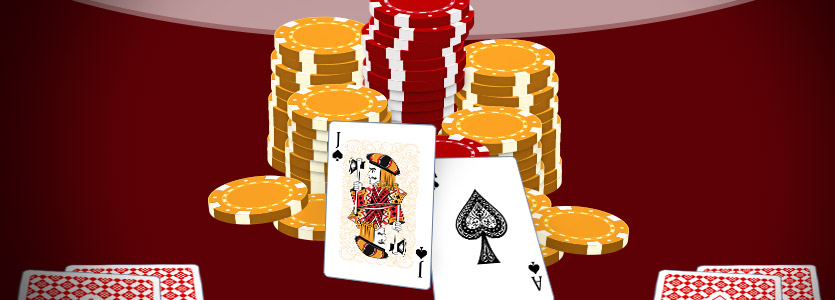
Throughout the latter half of the twentieth century, the blackjack card game was undoubtedly the king of the tables. It was the casino game that everyone flocked to with a simple structure that enticed beginners and featured a rewarding methodology that tested the more experienced gambler. It probably didn’t hurt either that it had been immortalized so often in film.
Blackjack was fun, strategic, and enjoyed a reputation of Hollywood cool. James Bond played it after all, even if he was more partial to baccarat.
Around the 2000s however, the game’s popularity began to experience a slight slump, with poker becoming the star of the show. Only then the internet took off.
While online gambling’s rapid growth played a huge part in poker’s boom, it was also a considerable shot in the arm for blackjack that perhaps was in danger of starting to feel a little old-fashioned.
Now though it was reborn, with the game’s premise perfect for online gaming due to its accessibility, fast pace, and demanding decisions that have dramatic consequences. In recent years, millions of people have discovered the joys of blackjack, and it naturally follows that a good many of them have subsequently sought out the thrill of a live game.
Once again, blackjack is the king of the tables.
Reasoning why it has sustained its popularity through the decades leads us to these key factors:
It Is Fast Paced Though this has already been mentioned, it is worth repeating because these days a person is as likely to squeeze in half an hour’s play on their smartphone during a lunch break as they are to spend a whole evening online or visiting a casino. Blackjack is custom-made for a bite-sized gambling hit. Low House Edge By applying basic strategy, the house’s advantage can be reduced to as little as 0.5% which is by far the lowest of all casino games. This sees people return to the tables time and again. It Is A Game Of Skill Blackjack is one of the few casino games where player skill can significantly influence gameplay. | % Chance Of Winning Hand The probability of winning a hand before any cards are dealt is 46.3%. Compare this to a multi-player poker game where eight or so others are invested and it’s clear that blackjack offers a much better chance of winning out. It’s solely the player vs the dealer. A coin-flip. Use Of Strategy Directly linked to skill, many players derive pleasure from beating the house using calculations that inform them when to hit, stand, split, or surrender. Learning basic strategy levels the playing field. 3:2 Payout If hitting a natural blackjack hand is not exciting enough, then seeing £25 returned from a £10 bet is sure exciting. On average a natural blackjack is hit once every 21 hands. They are worth staying around for. | Basic Rules Are Rigid This is an important consideration, because this contributes to blackjack’s global appeal. Once the rules and techniques of the game have been learnt, it can be enjoyed in a Las Vegas casino, online, or during your travels. It Is A Social Game Because players are not in direct competition with each other, blackjack tables are usually always a friendly space. |
Maybe there is no feeling quite like it, but there is sadly a polar opposite and the most crucial lesson from all of the advice given in this guide is this: If you are chasing your losses; or if you’re feeling dependent on blackjack to induce excitement, then please stop. Step away from the table. Step away from the screen.
If played sensibly and within your means, blackjack is a fun pursuit that can be immensely rewarding.
It is for these reasons and more why it remains evergreen and popular around the world.
BUT IS BLACKJACK REALLY BEATABLE?
A common misconception is that blackjack can only be beaten by memorizing the cards. It is a myth compounded by the best-selling book ‘Bringing Down The House’ – later made into a film – that tells the story of MIT students who cleaned up in Vegas.
In reality, however, it requires the intellect of a genius to do this. It is an ability that is beyond most.
In 1962, a book called ‘Beat The Dealer’ was first published, proclaiming it was a ‘unbeatable winning blackjack system’. In truth, it was, to a very select few at least who were able to take on the ‘ten count’ card-counting system. For the rest, it proved to be an impossible challenge.
Yet the book’s success was enough to make the casinos jittery. First, they took the unpopular step of revising the rules in their favor, making changes that were later reinstated under protest. In time, they settled on expanding a single deck of cards for a multi-deck. If you needed to be smart before, now it was necessary to be Stephen Hawking smart.
Optimizing your chances of winning at blackjack does not require the memorizing of cards. Instead, it is possible by adhering to basic strategy while taking advantage of the constantly changing odds. This is done by:
Tracking Aces And 10-Value Cards If a large number are yet to be played that means the deck is loaded which will result in more blackjacks for the player. Granted, the same applies to the dealer but remember that a player gets 3:2 on a natural blackjack whereas a dealer does not. | Using A Plus And Minus System This is done by assigning a value of plus-one to 3 – 6 and a minus-one to tens, jacks, queens and kings. All other cards are neutral. By adding or subtracting from the ‘running count’ as these cards are dealt it is eventually possible to divide this figure by the number of decks left in the shoe. This gives a player a ‘true count’. |
There will always be those seeking as much ‘edge’ as possible, but dangers come with that. It is more advisable therefore to stick with basic strategy and by all means take careful note if more weak cards are appearing than premium ones.
THE STORIED HISTORY OF BLACKJACK
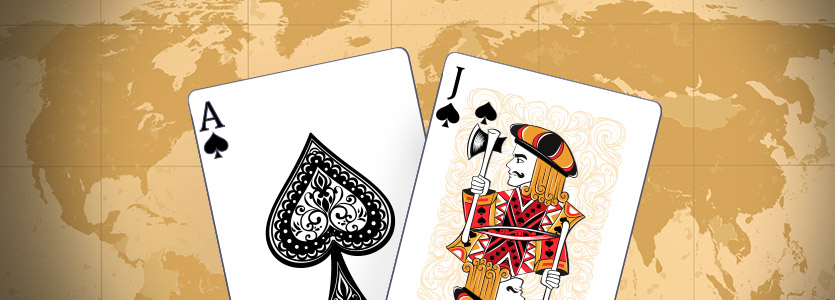
The 21 card game has a lineage that is rich and fascinating; a journey that is thought to date all the way back to Roman times when wooden blocks with numbers were used with the original 21 card game rules. Though this has not been proven beyond a doubt, it remains a theory many historians hold to be true due to the popularity of gambling during that period.
In the early 1600s, a game termed ‘twenty-one’ was first culturally name-checked in the novel Ronconete y Cortadillo that featured card cheats in Seville, Spain. Then, as now, aces counted as one or eleven points.
It was in France, however, that the game really took hold with a forerunner of Blackjack called Vingt-et-Un (One and Twenty). That quickly became in vogue within the upper echelons of Parisian society that learned how to play 21 from a young age. Italy meanwhile had its own variation and though each had a unique selling point and key differences, the basic tenets of the pastime were the same. Across Europe, the appeal of this deceptively straightforward pursuit was catching fire.
Vingt-Et-Un Popular in French casinos in the 1700s, where many originally learned how to play 21 games, this precursor to blackjack had a similar hand-ranking system and ultimate goal of getting closest to 21. Where it significantly strayed from the game we know today was that players would wager after their hands were dealt, not before, and furthermore the dealer could double everyone’s bet once their own initial card had been dealt. If this skewed the odds in the dealer’s favor, it only got worse because should they hit a ‘natural’ (a hand reaching 21), players would pay the dealer triple. Sette E Mezzo The Italian equivalent translates as ‘seven and a half’ and unsurprisingly the aim was to reach that figure without going over. Face cards counted as half a point with 8s, 9s and 10s counting as one. Interestingly, the term ‘busted’ is believed to originate from this variation. | Trente-Un The Spanish version challenged the player to get as close as possible to 31 points by drawing cards. In this game, face cards had differing values with Jacks worth 11 points, Queens 12, and Kings 13. The objective was made harder by needing to reach their target with three cards of the same suit. French Quinze This is a direct descendant of Vingt-et-Un that was believed to have been played in the court of King Louis XV. Here, the only major difference was players competed to acquire a hand of 15 rather than 21. |
When French colonists took their game around the globe in the 1900s, North America seemed uninterested in its charms, but the big turning point came in 1931 when the state of Nevada legalized gambling.
Casino owners quickly realized that a lot of profit could be made from the game that was still christened ‘21’, especially as all the advantages lay with them. At that time, players acted before the dealer and if they exceeded the 21 threshold, they would automatically cede the hand. This gave the house a considerable edge.
Consequently, this unfamiliar and fun pastime held little appeal to the average player who sought their gambling thrills elsewhere. That was until Nevada’s finest made dramatic changes to even up the odds, perhaps appreciating that to allow this game to fall at the first hurdle was hardly in their own self-interest.
Blackjack card rules were altered, meaning that dealers were now required to ‘hit’ on 16 and ‘stand’ on 17 through to 21. The players meanwhile were afforded a range of new options that included the ability to double down and split pairs. They were also now paid 3-to-2 on hitting 21.
Yet, still the American public was bored, still they turned away, and this necessitated a further inducement. For a short period, tremendous odds of 10-to-1 were offered to any player dealt a hand that consisted of an ace and either of the black jacks. ‘21’ soon became known as something else entirely.
As with any well-established pastime, blackjack’s rise to prominence was not a gradual and steady journey but rather it experienced booms at different moments in time. In 1956, a book called Playing Blackjack To Win was published to widespread acclaim after being written by four men who referred to themselves within the text as the ‘Four Horsemen Of Aberdeen’. The quartet in question reasoned that it was possible to be consistently successful by adhering to basic strategies and following specific rules: that it was feasible to ‘keep track’ of the cards.
If the casinos didn’t pay much attention to this publication, they certainly became alarmed at Edward O. Thorp’s book ‘Beat the Dealer’, making the New York Times list of best-sellers in 1962. It was a book that highlighted a card counting system that still today has a calculation named after one of his methods: the ‘Thorp Ratio’. Indeed, Las Vegas casinos were so concerned they briefly made the game more prohibitive towards the player over the dealer until a wave of protest made them instead settle on changing the dealing shoe from holding one deck of cards to four.
In hindsight, they should not have been so worried. A surge of gamblers, emboldened by having read Thorp’s book, headed to the casinos and profits naturally soared.
Since then blackjack has become a staple of casinos worldwide, its popularity and reputation heightened further still by featuring in several iconic movie scenes.
In 2008, the movie ‘21’ made blackjack itself the star and the game’s regular appearances on celluloid is hardly surprising given that its apparent simplicity lends itself perfectly to drama.
In real life and on film, blackjack continues to flourish and online too its popularity is huge, with millions playing daily for fun.
It’s been quite a journey from back when the Romans dealt their wooden blocks.
BLACKJACK BASICS
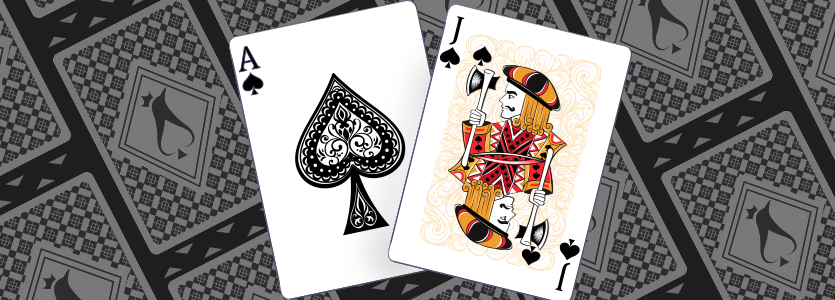
To summarize, this is a guide that covers all of the main bases of blackjack, a pontoon game that is easy to understand but hard to master. The key takeaways include:
Explaining The Rules
From ‘hitting’ to ‘standing’, ‘splitting’ to ‘doubling down’, blackjack offers a wealth of in-game options to the player. A comprehensive understanding of these elements is critical in assisting players – regardless of their skill level - as they aim to beat the dealer.
An intuitive appreciation of hand strengths is also crucial and various combinations are put under the spotlight, along with useful tips on how best to play them.
Variations of the game can see a single deck used or multiple decks and each have their own set of rules regarding what the dealer can and cannot do, mostly with a hand that amounts to 17. A player’s options also differ depending on deck sizing. These varying circumstances are explained above.
Basic Strategy
For well over half a century, basic strategy has been the blueprint all blackjack players have turned to in order to optimize their chances of success. It is a compendium of proven calculations that ensure each hand is played in the mathematically correct manner.
Knowing when to surrender a hand, in what situation it is shrewd to place an insurance bet, and the best spots to double down amounts to invaluable information for any player.
Blackjack’s Appeal
An immensely popular pursuit since the 1600s, Blackjack’s global appeal persists to this day, having been given a new lease of life online.
This guide seeks to explain why it remains the king of the tables.
Understanding Its Protocols
Blackjack casino etiquette can be intimidating to the beginner and breaking down and making sense of the various do’s and don’ts is vital so that a player feels at ease at the table.
From initially taking a seat to knowing when it is permissible to handle the chips, all is covered here along with advice on tipping and guidance too on how best to signal your intentions during a hand.
Establishing If It Is Beatable
It is highlighted here that the game boasts a much lower ‘House Edge’ to any other game of its kind.
Detailing The Game’s History
This guide celebrates blackjack’s rich and storied past that very possibly dates all the way back to Roman times. From its early European incarnations to the familiar game we know and love today, it has been quite some journey.


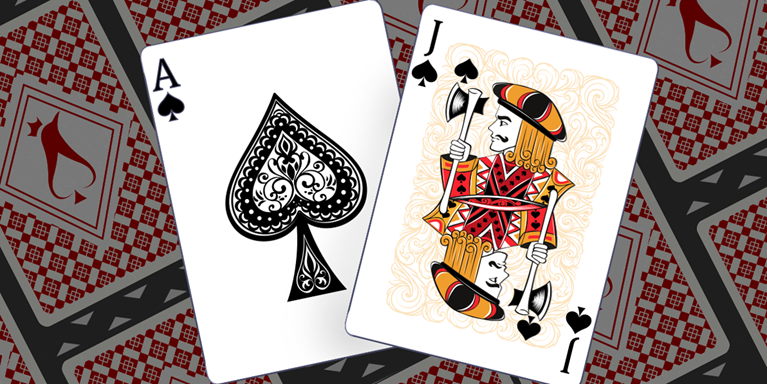
-hc1yApqD3q.jpg)
-A0otsXkXH0.jpg)
-8cD4JThn68.jpg)

